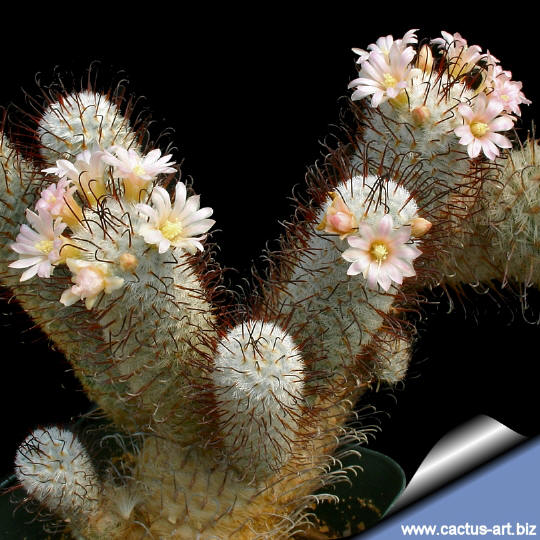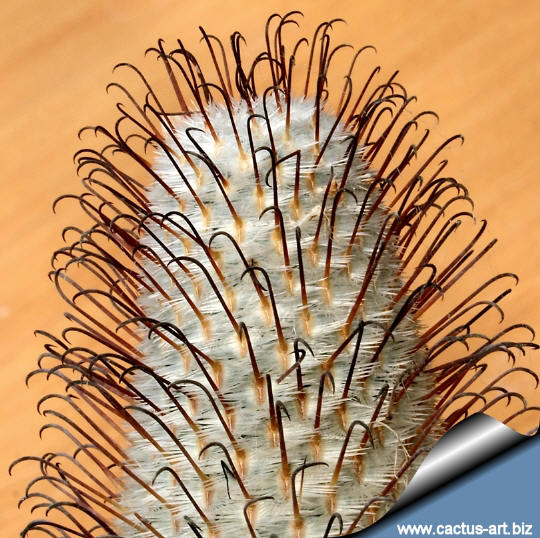|
|
|
Family:
Cactaceae
(Cactus Family)
Scientific name:
Mammillaria
perezdelarosae
H. Bravo & L. Scheinvar
In: Cact. Succ. Mex.
30(4): 76 (1985)
(Oftens found as
M. perez-de-la-rosae)
Origin: Mexico, Jalisco, Aguascalientes
(Zacatecas ?) Altitude
2.000 - 2.400 m.
M. bombycina is closely related
, however they are basically
different plants. They are vaguely similar for spines but the
bombycina
forms readily large clumps while the perezdelarosae
offsets very slowly over the
years and usually with no more than 2-3 offsets per plant. Both
species are of easy culture and have consistently clean spination
whether grown indoors or out.
Synonyms:
- Mammillaria
bombycina Quehl ssp. perezdelarosae ( H. Bravo &
L. Scheinvar) D.R. Hunt 1997
- Escobariopsis
perezdelarosae (H. Bravo & L. Scheinvar) Doweld 2000
- Mammillaria
perezdelarosae ssp. Andersoniana Fitz Maurice & B. Fitz
Maurice, 2001
|
|
Description: This is one of the more beautiful Mammillaria, with
smallish stems densely covered with curious bicoloured spines. It
combines clean, glassy white radial spines with hooked dark-brown
centrals. At first it stay solitary but will offsets with time.
Occasionally, plants will offset when quite young, and dense clumps of
spherical bodies will result. Growth is slow to moderate, and the best
plants are grown somewhat slowly to conserve the dense spination. It is
closely related to M. bombycina.
Stem: Globular depressed, becoming columnar with age, bright dark
green 3,5-5 cm in diameter, or more, 5-7 cm tall (up to 15 cm tall in
cultivation) Usually without latex.
Tubercles: Conical with rounded tips. Axil with bristles.
Radial spine: 30 - 60, pectinately arranged, needle- to hair-like,
white with yellowish bases, 2 - 3.5 mm long.
Central spine: 1 - 2, ascending, dark red, 11 - 14 mm long,
lowermost one hooked.
Flowers: Greenish white, cream to light pink , with a slightly
darker midstripe are up to 20 mm long and 2,5 cm in diameter.
Blooming season: Flowers come in late winter.
Fruit: Red.
Seed: Brownish black
|
|
|


Cultivation: Need regular water but do not water again until
dry, as it is specially sensitive to over
watering; plants should be allowed to become crowded in their pot.
Keep in shallow pot. Also,
it is a species that is dormant in the winter and require very little
water (maybe even none) during the cold months.
Frost Tolerance: Light frost protection
required. Minimum of 5ºC for safe growing (but hardy up to -5°C or
less.)
Sun Exposure: High levels of light are needed to
flower and for good spine development.
Can be sunburned if moved
from shade/greenhouse into full sun too quickly. During the spring it
may be able to take full sun until the heat arrives at the end of
spring. In an area that has hot afternoon sun, it may be able to take
full morning sun, but requires afternoon shade or afternoon light shade.
If grown correctly, it will reward the grower with generous
displays of purple flowers.
Propagation: Seeds (usually) or offsets that appear at the
base; leave them attached to form a cluster, or wait until they are 1/3
the size of the parent and then detach and plant.
Conspecific taxa, varieties, forms an
cultivars:
|
|